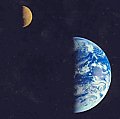« Vowel Glut |
Main
| Good Money After Bad »
Natural Wonder
We went on a shore dive on Thursday. It was our first dive, and we wanted to get familiar with the equipment (Patricia had a new wet suit and fins) before we went on our more serious boat dives.
The place we chose was called (uncharacteristically for Hawaii, in which almost all the place names are Hawaiian) La Perouse Bay, which was named by some Frenchman. It's at the extreme south end of the island, well past the last resort at Wailua. It's accessible only via a narrow, barely-paved road. In order to get to it, one must traverse an extensive field of fresh lava. Well, fresh in geological terms. It's the remnants of the last eruption of Haleakala, over two hundred years ago.
It was a pyroclastic flow, very much like the one that is going on right now at Kilaulea on the island of Hawaii itself. It burst through the mountain and poured down the hillside to steam the sea as it cooled and expanded the acreage of the island.
As one drives along the road that's been carved out of it, one can look up the hill and see the stark black infertile scar, all the way up to the source, where a hill was sliced in two by the molten rock.
Looking at the barren, jagged landscape on either side, Patricia remarked that it looked like someone threw up there and didn't clean it up.
Very poetic. Think of it as the gruesome results of some vast god with a titanic bellyache, and vomit black as midnight on a new moon.
Gaia's gut juice. Spew of Mother Earth.
Nature is not always our friend.
Posted by Rand Simberg at October 30, 2002 03:25 PM
TrackBack URL for this entry:
http://www.transterrestrial.com/mt-diagnostics.cgi/453
Listed below are links to weblogs that reference
this post from
Transterrestrial Musings.
Comments
There is a place just near Sydney, Australia called La Perouse. Apparently he got to Australia about 3 days after the British. So Australia narrowly escaped being French.
Posted by Patrick at October 30, 2002 09:57 PM
A small correction, pyroclastic flows aren't the usual lava eruptions you see in Hawaii but are often much more destructive. As I understand it, it's more of a super-heated superslippery landslide with a mixture of hardened lava, ash, and gas that can travel hundreds of miles per hour. The 1980 Mount St Helens eruption that killed 61 people is a recent example of a large pyroclastic flow. It's not clear to me what the circumstances are for a pyroclastic flow in Hawaii. But I recall that US West coast pyroclastic flows often occur in the later stages of a volcano's lifespan when the erupting lava has cooled down and grown thick and stiff. It's much more likely to be explosive in that case. Hawaii lava tends to be hot and fluid with relatively little disolved gas. Further there are some chemistry differences that apparently exaggerate the viscosity gap between fluid Hawaiian lava and stiff US West coast lava.
Posted by Karl Hallowell at October 31, 2002 04:53 PM
Post a comment

